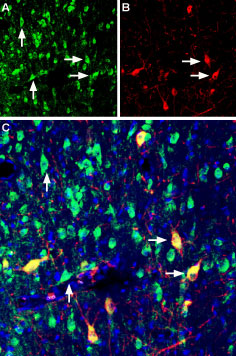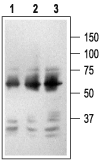Overview
- Solubilized proteins from PC12 membranes.
P07174
24596
 Multiplex staining of Plexin-A2 and p75NTR in rat brainImmunohistochemical staining of perfusion-fixed frozen rat brain sections using Anti-Plexin-A2 (extracellular) Antibody (#APR-082), (1:400) and Mouse Anti-Rat p75 NGF Receptor (extracellular) Antibody (#AN-170), (1:300). A. Sections of rat horizontal diagonal band (HDB) were stained for Plexin-A2 (green). B. Same sections were stained for p75NTR (red). C. Merge of the two images reveals cells expressing both Plexin-A2 and p75NTR (horizontal arrows), cells expressing only Plexin-A2 (upwards pointing arrows) or cells expressing only p75NTR (downwards pointing arrows) can also be observed. Cell nuclei are stained with DAPI (blue).
Multiplex staining of Plexin-A2 and p75NTR in rat brainImmunohistochemical staining of perfusion-fixed frozen rat brain sections using Anti-Plexin-A2 (extracellular) Antibody (#APR-082), (1:400) and Mouse Anti-Rat p75 NGF Receptor (extracellular) Antibody (#AN-170), (1:300). A. Sections of rat horizontal diagonal band (HDB) were stained for Plexin-A2 (green). B. Same sections were stained for p75NTR (red). C. Merge of the two images reveals cells expressing both Plexin-A2 and p75NTR (horizontal arrows), cells expressing only Plexin-A2 (upwards pointing arrows) or cells expressing only p75NTR (downwards pointing arrows) can also be observed. Cell nuclei are stained with DAPI (blue).
- PC12 cells.
- Dechant, G. et al. (1997) Curr. Opin. Neurobiol. 7, 413.
- Cosgaya, J.M. et al. (2002) J. Science 298, 1245.
- Yamashita, T. et al. (2003) Nature Neurosci. 6, 461.
- Bentley, C.A. et al. (2000) J. Neurosci. 20, 7706.
- Lee, R. et al. (2001) Science 294, 1945.
- Bibel, M. et al. (2000) Genes Dev. 14, 2919.
- Salehi, A.H. et al. (2002) J. Biol. Chem. 277, 48043.
- Casademunt, E. et al. (1999) EMBO J. 18, 6050.
- Yaar, M. et al. (1997) J. Clin. Invest. 100, 2333.
p75NTR known as a cell surface receptor for NGF, BDNF, NT-3 and NT-4, is also a receptor for b-amyloid, and for the myelin axon repellant protein MAG.1,2,4,6 Binding of neurotrophins induces receptor dimerization followed by phosphorylation of receptor kinase residues and recruitment of intracellular proteins involved in signal transduction.
p75NTR functions alone, or in functional complexes with the neurotrophin receptors trkA, trkB and trkC. p75NTR signals via interaction with different transducers such as TRAF6, IRAK, and RIP-2, activating NF-κB, JNK and p38, and inactivating rhoA.1,3,6
Receptor degradation is mediated by a metalloproteinase-dependent shedding of the extracellular domain. p75NTR binds all neurotrophins with similar nM affinity, but binds pro-neurotrophins with greater affinity, and is more potently activated by pro-neurotrophins.5
Overexpression of the intracellular domain in developing neurons induces apoptosis. NGF-dependent association of NRIF with p75NTR contributes to pro-apoptotic signaling.7,8
Beta-amyloid peptide binds p75NTR and stimulates pro apoptotic signaling by p75NTR, suggesting that the receptor may be relevant for Alzheimer's disease.9
Application key:
Species reactivity key:
Mouse Anti-Rat p75 NGF Receptor (extracellular) Antibody (#AN-170) is a highly specific monoclonal antibody directed against p75NTR. The antibody can be used in western blot, immunohistochemistry, and indirect flow cytometry applications. It has been designed to recognize p75NTR from rat samples only.
 Multiplex staining of Vesicular Acetylcholine Transporter and p75NTR in rat medial septum.Immunohistochemical staining of immersion-fixed, free floating rat brain frozen sections using rabbit Anti-Vesicular Acetylcholine Transporter (VAChT) Antibody (#ACT-003), (1:200) and Mouse Anti-Rat p75 NGF Receptor (extracellular) Antibody (#AN-170), (1:200). A. VAChT staining (green) appears in several neuronal cells. B. p75NTR (red) also stains neuronal cells. C. Merge of the two images shows colocalization of VAChT and p75NTR in some cells (horizontal arrows), while other cells express only VAChT (vertical arrows). Cell nuclei are stained with DAPI (blue).
Multiplex staining of Vesicular Acetylcholine Transporter and p75NTR in rat medial septum.Immunohistochemical staining of immersion-fixed, free floating rat brain frozen sections using rabbit Anti-Vesicular Acetylcholine Transporter (VAChT) Antibody (#ACT-003), (1:200) and Mouse Anti-Rat p75 NGF Receptor (extracellular) Antibody (#AN-170), (1:200). A. VAChT staining (green) appears in several neuronal cells. B. p75NTR (red) also stains neuronal cells. C. Merge of the two images shows colocalization of VAChT and p75NTR in some cells (horizontal arrows), while other cells express only VAChT (vertical arrows). Cell nuclei are stained with DAPI (blue).
Applications
Citations
- Urra, S. et al. (2007) J. Biol. Chem. 282, 7606.
- Tan, J. et al. (2006) Am. J. Pathol. 169, 528.
- Kuwako, K. et al. (2005) J. Neurosci. 25, 7090.
- Tcherpakov, M. et al. (2002) J. Biol. Chem. 277, 49101.

